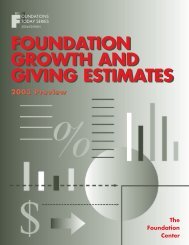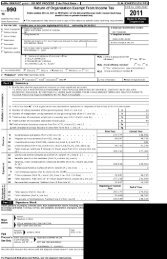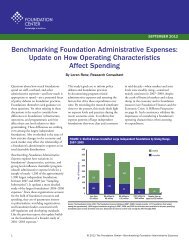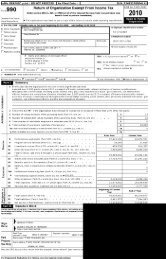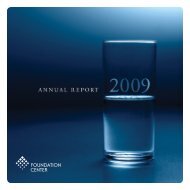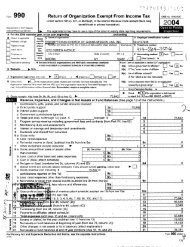Download Philanthropy Annual PDF - Foundation Center
Download Philanthropy Annual PDF - Foundation Center
Download Philanthropy Annual PDF - Foundation Center
Create successful ePaper yourself
Turn your PDF publications into a flip-book with our unique Google optimized e-Paper software.
For More Commentary & Opinion visit<br />
http://foundationcenter.org/pnd/commentary/<br />
GO<br />
Performance Measurement:<br />
Put a Stake in the Ground<br />
By Andrew Wolk, CEO and founder, Root Cause<br />
If you are a nonprofit leader operating in today’s hardscrabble<br />
environment, you’re undoubtedly spending<br />
an exceptional (and unacceptable) amount<br />
of time looking for support and fiercely<br />
competing for shrinking philanthropic<br />
dollars. No matter how good your program<br />
is, you may be one of many who are only a<br />
few months shy of having to fold your tent.<br />
So the one thing you probably don’t want to hear is what may sound like<br />
cold business-speak: take time, now, to gather and dive more deeply into<br />
hard data. Get better at measuring your performance.<br />
Business discipline for nonprofits is not an oxymoron. Better measurement can<br />
help, not hinder, your mission. It’s a key to your success, perhaps even your survival.<br />
Contrary to the fears of some, it doesn’t have to be complicated or overwhelming.<br />
Done thoughtfully, it can be your secret weapon, resulting in significant improvements<br />
in your operations, an invaluable learning experience and cultural shift for<br />
your staff, better communication with your funders, and a reliable roadmap toward<br />
increased social impact.<br />
The pressure on nonprofits to prove their worth has never been greater. Doing<br />
good is no longer good enough. Today there’s a spotlight on better measurement,<br />
all the way from the top. Sonal Shah, head of the new White House Office of Social<br />
Innovation, said at the recent SoCap09 panel on which I served that measurement<br />
is the “major theme” as the social enterprise sector grows up.<br />
President Obama set the tone in June when he outlined the plan for new Social<br />
Innovation Fund: to find the “most promising nonprofits in America, examine<br />
their data and rigorously evaluate their outcomes. . . . We’ll invest in those with the<br />
best results that are most likely to prove a good return on our taxpayer dollar.”<br />
Every time I talk with a social impact investor — whether an individual donor<br />
or from a foundation, government agency, or company — one theme resonates:<br />
“What works?” Social impact investors tell us that, unlike their experiences in the<br />
private capital market, they often find it difficult in the nonprofit sector to access<br />
reliable, insightful, and useful information about performance. They want more<br />
transparency and more proof that your organization is well run, sustainable, and<br />
making a difference.<br />
“I know what social issues I feel passionate about funding,” one frustrated<br />
philanthropic investor told us in a common refrain. “But I don’t understand which<br />
organizations within those social issues are making the most difference.”<br />
Your measurement must be meaningful. Many organizations publish annual<br />
reports that track their budgets and client numbers. Far fewer take on the challenge<br />
of measuring social impact<br />
— uncovering and reporting,<br />
through hard data as well as<br />
personal stories, their progress toward<br />
realizing their mission.<br />
We at Root Cause found that, over<br />
the last three years, all the applicants to<br />
our Social Innovation Forum whose<br />
statistics we tracked used some form of<br />
measurement, including financial health<br />
and client growth. But only one-third<br />
of them were engaged in meaningful<br />
measurement of impact.<br />
Our own experience this past year<br />
illustrates how using performance measurement<br />
is well worth the effort.<br />
In a search for better ways to measure<br />
social impact work beyond the<br />
usual financial statements, we asked<br />
half a dozen gutsy leaders of small to<br />
medium-size nonprofits in the greater<br />
Boston area who had been selected<br />
as Root Cause “social innovators” to<br />
participate in a year-long pilot program<br />
to improve their performance<br />
measurement.<br />
They agreed to come up with new<br />
measurement indices tailored to their<br />
organizations and follow the results<br />
closely for a year, checking in quarterly<br />
to report their progress. At the end of<br />
the year, they shared their results in<br />
public reports and a panel discussion<br />
before curious potential investors —<br />
the upsides, the downsides, the “aha”<br />
moments of more transparency and<br />
accountability.<br />
All of them reported that developing<br />
a customized, data-driven performance<br />
measurement system took a bit<br />
of work; occasionally they had to go<br />
back to the drawing board. But their<br />
efforts proved powerful in giving them<br />
a clearer picture of how well their<br />
mission matched their programs and<br />
provided more convincing evidence<br />
to potential donors that their money<br />
would be invested in ideas that worked.<br />
Organizations that complete the<br />
Social Innovators program grow an<br />
People Who Make a Difference | 49





